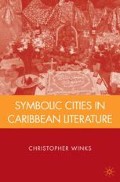Abstract
The ancient city of Wagadu as it emerges from the tale “Gassire’s Lute” is less a domain of conviviality than a backdrop for the human passions and frailties that cause it to vanish and later reappear. Fundamentally, while Wagadu’s existence as metaphor defines each of its successive incarnations in terms of a specific discovery or achievement, its utopian content is only gestured toward without ever being described, since its fullest realization can only occur in an indeterminate future and within the individual body-soul, where “every man will have Wagadu in his heart and every woman a Wagadu in her womb.” There is, however, another Wagadu tale in which the great city is described as a place of surpassing material and intellectual wealth:
Its fields produced rich harvests, and traders came to that city from all directions to deal in cloth, gold and wares from distant lands. In Wagadu were great markets, and portions of the city were set aside for blacksmiths, goldsmiths, leatherworkers and craftsmen of all kinds. Many languages were heard in the streets—Manding, Fula, Hausa, Arabic and others. There were scholars, Muslim teachers of the Koran, and practitioners of the mystic sciences. The name Wagadu signified “infinitely deep,” and it was in fact such a city, complex and profound in its variety and wonders. Whatever men sought after, they went to Wagadu to find.1
Access this chapter
Tax calculation will be finalised at checkout
Purchases are for personal use only
Preview
Unable to display preview. Download preview PDF.
Notes
Harold Courlander and Ousmane Sako, The Heart of the Ngoni (New York: Crown, 1982), 13.
Nicolás Guillén, “Arrival,” in Cuba Libre, trans. Langston Hughes and Ben Frederic Carruthers (Los Angeles: Ward Ritchie, 1948), 61–62.
Antonio Benítez-Rojo, The Repeating Island: The Caribbean and the Post-Modern Perspective, 2nd ed., trans. James E. Maraniss (Durham, NC & London: Duke University Press, 1996), 125.
Virgilio Piñera, “Mitificación de Santiago de Cuba,” in Poesía y critica, ed. Antón Arrufat (Mexico City: Consejo Nacional para la Cultura y las Artes, 1994), 296; my translation.
Emma Álvarez-Tabío Albo, Invención de La Habana (Barcelona: Casiopea, 2000), 27; my translation.
Piñera, “Electra Garrigó,” in Teatro Completo (Havana: Ediciones R, 1960), 37; my translation.
Eliseo Diego, “El primer discurso,” in Entre la dicha y la tiniebla: Antología poética 1949–1985, ed. Diego García Elío (Mexico City: Fondo de Cultura Económica, 1986), 15; my translation.
Abilio Estévez, “La Habana, esa alucinación,” in La Habana Elegante (Winter 2000), http://www.habanaelegante.com/Winter2000.Ronda.htm; my translation.
Alejo Carpentier, “Problemática de la actual novela latinoamericana,” in Ensayos (La Habana: Letras Cubanas, 1984), 11; my translation.
Italo Calvino, Invisible Cities, trans. William Weaver (New York & London: Harcourt Brace Jovanovich, 1974), 11.
Alejo Carpentier, La ciudad de las columnas (Barcelona: Bruguera, 1985), 95; my translation; all subsequent page references incorporated parenthetically into the body of the text.
Charles Baudelaire, “Correspondances,” Les fleurs du mal, trans. Richard Howard (Boston: David R. Godine, 1983), 193.
Alejo Carpentier, The Chase, trans. Alfred Mac Adam (New York: Noonday, 1989), 31; all subsequent page references incorporated parenthetically into the body of the text.
Roberto Gonzalez Echevarría, Alejo Carpentier: The Pilgrim at Home (Austin: University of Texas Press, 1990), 206.
José Lezama Lima, “Señales: La otra desintegración,” in Orígenes 21 (1949): 60; my translation.
John Mason and Gary Edwards, Black Gods—Orisa Studies in the New World (Brooklyn: Yoruba Theological Archministry, 1985), 42.
Pedro Juan Gutiérrez, Dirty Havana Trilogy, trans. Natasha Wimmer (New York: Farrar Straus Giroux, 2001), 222.
Kamau Brathwaite, “Jazz and the West Indian Novel,” in Roots (Ann Arbor: University of Michigan Press, 1993), 107.
G. Cabrera Infante, Three Trapped Tigers, trans. Donald Gardner and Suzanne Jill Levine in collaboration with the author (New York: Harper & Row, 1971), 25; all subsequent page references incorporated parenthetically into the body of the text.
Fernando Ortiz, Cuban Counterpoint: Tobacco and Sugar, trans. Harriet de Onis (New York: Knopf, 1947), 3–4.
José Martí, “Dos patrias,” in Obra poética (Miami: La Moderna Poesía, 1983), 175; my translation.
Robert Farris Thompson, Flash of the Spirit African and Afro-American Art and Philosophy (New York: Vintage, 1984), 109.
Cristóbal Díaz Ayala, Música Cubana, Del Areyto a la Nueva Trova, 2nd ed. (San Juan, Puerto Rico: Cubánacan, 1981), 249; my translation.
Robert Farris Thompson, Face of the Gods: Art and Altars of Africa and the African Americas (New York/Munich: Museum of African Art/Prestel, 1993), 63.
Carlos Franqui, Retrato de familia con Fidel (Barcelona: Seix-Barral, 1981), 66; my translation; paragraphing altered from original.
Reinaldo Arenas, Before Night Falls, trans. Dolores M. Koch (New York: Viking, 1993), 52.
Eliseo Alberto, Informe sobre mi mismo (Mexico City: Alfaguara, 1997), 130–31; my translation.
Copyright information
© 2009 Christopher Winks
About this chapter
Cite this chapter
Winks, C. (2009). Two, Three, Many Havanas. In: Symbolic Cities in Caribbean Literature. Palgrave Macmillan, New York. https://doi.org/10.1057/9780230621572_4
Download citation
DOI: https://doi.org/10.1057/9780230621572_4
Publisher Name: Palgrave Macmillan, New York
Print ISBN: 978-1-349-37688-9
Online ISBN: 978-0-230-62157-2
eBook Packages: Palgrave Literature & Performing Arts CollectionLiterature, Cultural and Media Studies (R0)

